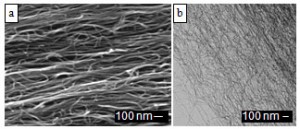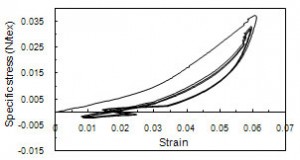Storing Energy in Carbon Nanotube Springs

Figure 1: (a) SEM image of a fiber densified using capillary effects and (b) TEM image of undensified CNTs within a fiber.
The goal of this project is to study the potential of storing energy in the elastic deformation of carbon nanotubes (CNTs). The work is motivated by the exceptional mechanical properties of CNTs, including a Young’s modulus of 1 TPa, experimentally demonstrated elastic strains of 6% [1], and theoretically predicted elastic strains in the absence of defects as high as 20% [2]. Springs made of well-ordered assemblies of CNTs are expected to store macroscopically significant amounts of energy with a density three orders of magnitude greater than that of steel springs and on the same order of magnitude as the energy density of lithium-ion batteries [3].

Figure 2: Specific stress plotted as a function of strain for a fiber made of CNTs loaded cyclically in tension.
Fibers are fabricated as representative springs from 3 to 6 mm tall forests of vertically aligned multi-wall CNTs grown by thermal chemical vapor deposition [4] [5]. The CNTs in the fibers are shown in Figure 1. The fibers are tested in tension to measure their mechanical properties and energy storage capabilities. The starting material has a low initial density of 0.01 – 0.02 g/cm3, and a range of techniques, including capillary-driven densification, mechanical compression and twisting, have been used to increase the density of the fibers. To date, the highest recorded specific strength and stiffness are 2 N/tex and 68 N/tex, respectively. Cyclic loading tests are performed to measure the recoverable energy that can be stored in the fibers. A stress-strain curve from a fiber loaded cyclically in tension is shown in Figure 2. The maximum strain energy densities measured to date are 5×103 kJ/m3 or 6.9 kJ/kg, which are comparable to the energy per unit volume and greater than the energy per unit mass of steel springs, but three orders of magnitude lower than the theoretically predicted maximum energy density of CNT springs.
References
- D.A. Walters, L. M. Ericson, M.J. Casavant, J. Liu, D.T. Colbert, K.A. Smith, and R.E. Smalley, “Elastic strain of freely suspended single-wall carbon nanotube ropes,” Applied Physics Letters, vol. 74, pp. 3803-3805, 1999. [↩]
- K.M. Liew, X. Q. Hea, and C.H. Wong, “On the study of elastic and plastic properties of multi-walled carbon nanotubes under axial tension using molecular dynamics simulation,” ActaMaterialia, vol. 52, pp. 2521-2527, 2004. [↩]
- F.A. Hill, T.F. Havel and C. Livermore, “Modeling mechanical energy storage in springs based on carbon nanotubes,” Nanotechnology, vol. 20, 2009 [↩]
- F.A. Hill, T.F. Havel, A. J. Hart, and C. Livermore, “Storing elastic energy in carbon nanotubes,” Journal of Micromechanics and Microengineering, vol. 19, 2009 [↩]
- F.A. Hill, T.F. Havel, A.J. Hart, and C. Livermore, “Characterizing the failure processes that limit the storage of energy in carbon nanotube springs under tension,” Journal of Micromechanics and Microengineering, accepted for publication, 2010. [↩]